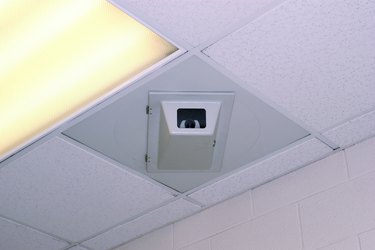 A dropped ceiling grid usually requires a 4-inch clearance. Image Credit: Thinkstock Images/Comstock/Getty Images
A dropped ceiling grid usually requires a 4-inch clearance. Image Credit: Thinkstock Images/Comstock/Getty Images
Dropped ceilings, which feature a horizontal grid usually made from lightweight metal and individual acoustical panels that fit in the grid, are standard in basements. A dropped ceiling gives basement rooms a finished look, while providing quick access to the mechanical elements that run between the joists. Houses are not identical, but general construction guidelines allow you to estimate the finished height of a dropped ceiling.
Video of the Day
Basement Walls
A standard basement wall is 8 feet high on the foundation's outside. An interior, poured-concrete floor reduces that measurement by 4 inches, which leaves 7 feet 8 inches from the top of the basement floor to the concrete wall's top. The addition of a sill plate, which sits on top of the concrete wall, adds 1 1/2 inches, bringing the standard unfinished basement room's height to 7 feet 9 1/2 inches.
Ceiling Grid Height
If the home's mechanical elements, such as drainpipes, heating and air ducts, and wiring, run between but not below the joists, the ceiling grid is installed approximately 4 inches below the joists. The acoustical panels, depending upon the type, may reduce the ceiling height another one-quarter inch. The height from the concrete floor to the dropped ceiling is about 7 feet 5 inches.
Flooring
Flooring adds less than one-quarter inch to the floor height if you install glue-down carpeting, linoleum or apply a rolled-on floor coating to the concrete. Laying ceramic tile or installing laminate flooring adds one-half to three-quarters inch to the floor's height, leaving at least 7 feet 4 inches between the floor and the dropped ceiling.
Considerations
Factors that influence a dropped ceiling's height of include plumbing or ductwork that extends below joist level. In general, install a dropped ceiling grid a minimum of 4 inches below the lowest joist or element. In industrial-type apartments with very high ceilings, installing a dropped ceiling saves heating costs. In this situation, local code determines the ceiling's minimum height, which is generally about 7 feet 6 inches.







































